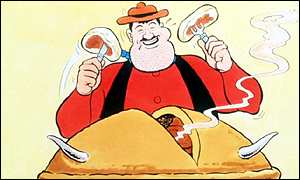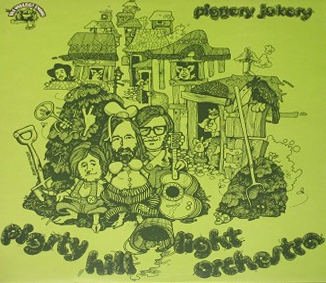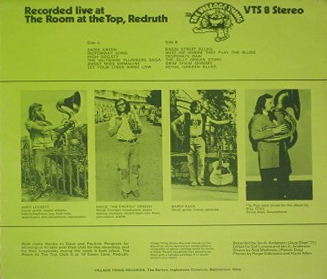The front cover and the Village Thing logo are by Rodney Matthews--in a
very different style than his later album covers for Magnum, Nazareth,
Tiger Moth, and others.
Throughout the album, David Creech and Andy Leggett are usually panned
left, while Barry Back and Bill Cole are usually panned right, although
Back's guitar occasionally creeps to the right.
The liner notes give credits for the album as a whole. The song-by-song
credits here are based on my own listening. Comments and corrections
are welcome.
-
Sadie Green
-
Barry Back: guitar
-
Bill Cole: string bass
-
David Creech: trumpet mouthpiece
-
Andy Leggett: vocal, kazoo, guitar
Written by Gilbert Wells and Johnny Dunn. The second verse of the PHLO's
version is Hilaire Belloc's poem "Henry King: Who chewed bits of string, and was
early cut off in Dreadful agonies" (from Cautionary Tales For
Children, 1907), with the name and defect changed.
Ms. Green was the subject of two different songs. "Sadie Green, The Vamp Of New
Orleans" was recorded by the Five Harmaniacs (1926), Jay C. Flippen (1926),
the Goofus Five (1926), Jim Kweskin (1965), and the Nitty Gritty Dirt Band (1968), among
others. "Everybody's Talking About Sadie Green" (written after she moved from New
Orleans to Memphis) was recorded by the Memphis Jug Band (1930) and the Even
Dozen Jug Band (1964).
Ms. Green also appeared in "How'm I Doin', Hey Hey" as recorded by Don Redman (1932)
and by the Mills Brothers (1932), although other recordings of the song had the name as
Tillie Green (Clara Smith, 1926), Betty Boop (Don Redman in the cartoon "I Heard",
1933), or Sadie Doreen (Aaron Sisters, 1932; Mountain Man, 2010).
-
Motorway Song
-
Barry Back: spoken introduction, lead vocal on intro, backing vocal, guitar
-
Bill Cole: string bass
-
David Creech: trumpet mouthpiece, backing vocal
-
Andy Leggett: lead vocal on verses, backing vocal, guitar
Written by one C. Brown. The PHLO recorded a reggae version on their
third LP.
-
High Society
-
Barry Back: guitar
-
Bill Cole: string bass
-
David Creech: trumpet mouthpiece
-
Andy Leggett: guitar, kazoo, whistle
Written by Armand Piron and Clarence Williams. Piron (1888-1943)
was a violinist and bandleader. He is also credited as the composer of
"I Wish I Could Shimmy Like My Sister Kate".
Clarence Williams (1893-1965) was a pianist and bandleader. As
publisher, he put his name on many songs, some of which he didn't
actually write but simply bought from the composer. He recorded "High
Society" four times between 1929 and 1933--each time with different
songwriting credits! Actor Clarence Williams III is his grandson.
The PHLO arrangement of "High Society" is probably based on the first
Clarence Williams recording (Okeh 8706, credited to Clarence Williams'
Washboard Band), which features an introductory verse not heard on his
later recordings of the song.
Clarence Williams was central to the PHLO's early repertoire. His "Cushion Foot Stomp", "Sweet Emmalina", "Shim Sham
Shimmy Dance", and "Royal Garden Blues" all
appear on their Village Thing LPs. And they released another version of
"High Society" on their third LP. (And
Piggies Andy Leggett and Henry Davies recorded it with Henry's
Bootblacks.)
-
The Wiltshire Plumbers Saga
-
Barry Back: commentary
-
Andy Leggett: lecture
Written by Andy Leggett. He can be seen holding a ballcockaphone
on the back cover of the LP.
-
Sweet Miss Emmaline
-
Barry Back: guitar, commentary, kazoo, backing vocal
-
Bill Cole: string bass
-
David Creech: trumpet mouthpiece, paper tearing, commentary
-
Andy Leggett: lead vocal, guitar, ballcockaphone, kazoo
"Sweet Emmalina" was written by Andy Razaf, Jack Palmer, and Clarence
Williams. It was recorded twice (vocal and instrumental) by Clarence
Williams in 1928.
Andriamanantena Razafinkarefo (1895-1973) was
the son of a Malagasy prince and the grandson of the American consul to
Madagascar. He also collaborated with Fats Waller, Eubie Blake, Don
Redman, and Chu Berry. His compositions include "Ain't Misbehavin'",
"Honeysuckle Rose", "In The Mood", "Christopher Columbus", "Dinah",
"That's What I Like About The South", "Stompin' At The Savoy", and "Gee,
Baby, Ain't I Good To You?"
-
Let Your Linen Hang Low
-
Barry Back: spoken introduction, lead vocal, guitar
-
Bill Cole: string bass, commentary
-
David Creech: lead vocal, trumpet
-
Andy Leggett: guitar, kazoo, backing vocal
Written by Kansas Joe McCoy. Recorded by Rosetta Howard with Hamfoot
Ham (Papa Charlie McCoy, Kansas Joe's younger brother) and the Harlem
Hamfats in 1937.
-
Basin Street Blues
-
Barry Back: spoken introduction, guitar, kazoo, backing vocal
-
Bill Cole: string bass
-
David Creech: trumpet mouthpiece, lead vocal
-
Andy Leggett: guitar, kazoo, backing vocal, jug
Written by Spencer Williams. Recorded by Louis Armstrong (1928,
1938), the Charleston Chasers with Jack Teagarden (1931), Bing Crosby
and Connee Boswell (1934), and Miles Davis (1963),
among others.
Spencer Williams (1889-1965) grew up on Basin Street in Storyville,
the red light district of New Orleans, where his aunt Lulu White was the
madam of the Mahogany Hall brothel. Williams also wrote "I Ain't Got
Nobody", "I Found A New Baby", and "Everybody Loves My Baby". He was not
related to Clarence Williams, although they collaborated on "Royal Garden Blues".
Charleston Chasers trombonists Glenn Miller and Jack Teagarden wrote
lyrics for the originally-instrumental piece, as well as the music for
the new verse ("Won't you come along with me...") that replaced
Williams' original verse.
-
Meet Me Where They Play The Blues
-
Barry Back: spoken introduction, occasional guitar, commentary
-
David Creech: spoken introduction, percussion
-
Andy Leggett: lead vocal, lead guitar
Written by Steve Allen and Sammy Gallop. Recorded by Jack Teagarden
(1950), Andy Williams (1956), Mary Coughlan (1985), and Maria Muldaur
(1999), but not, as far as I can tell, by Johnny Cash.
Steve Allen (1921-2000) hosted television talk shows (including
The Tonight Show) and game shows (including I've Got
A Secret), wrote over ten thousand songs (including the
Grammy-winning "Gravy Waltz"), and wrote over fifty books. Sammy Gallop
(1915-1971) was a lyricist who collaborated with a variety of
songwriters.
-
Desperate Dan
-
Barry Back: spoken introduction, guitar, backing vocal
-
Bill Cole: sousaphone
-
David Creech: trumpet mouthpiece
-
Andy Leggett: commentary, lead vocal, washboard
Written by Andy Leggett. Desperate Dan (created by Dudley Watkins) is
a character who appeared in the British comic book The Dandy,
which published 3,610 issues from 1937 through 2012 and continues on
line. It turns out that the cow pies he eats are not dung, but in fact
meat pies complete with horns.

Desperate Dan is also mentioned in "Village Green Preservation
Society" by The Kinks, "Joke Shop Man" by the Bonzo Dog Band, and
"Desperate Dan" by Hotlegs, the last of which also mentions cow pie.
-
The Silly Organ Story
-
Bill Cole: commentary
-
Andy Leggett: recitation
Written by Andy Leggett.
-
Shim Sham Shimmy
-
Barry Back: spoken introduction, lead vocal, guitar
-
Bill Cole: string bass
-
David Creech: trumpet mouthpiece, bulb horn
-
Andy Leggett: bird calls, washboard, kazoo, whistle, jug, backing vocal
"Shim Sham Shimmy Dance" was written by Andy Razaf (see "Sweet Miss Emmaline") and Clarence Williams (see
"High Society"). Recorded in 1933 by Williams'
Jug Band, with vocal by his wife, Eva Taylor.
-
Royal Garden Blues
-
Barry Back: spoken introduction, guitar, kazoo
-
Bill Cole: string bass
-
David Creech: trumpet
-
Andy Leggett: alto saxophone
Written by Spencer Williams (see "Basin Street
Blues") and Clarence Williams (see "High
Society"). Recorded by the Original Dixieland Jazz Band (1921), Bix
Beiderbecke (1927), Benny Goodman (1940), and Duke Ellington (1946),
among others.


